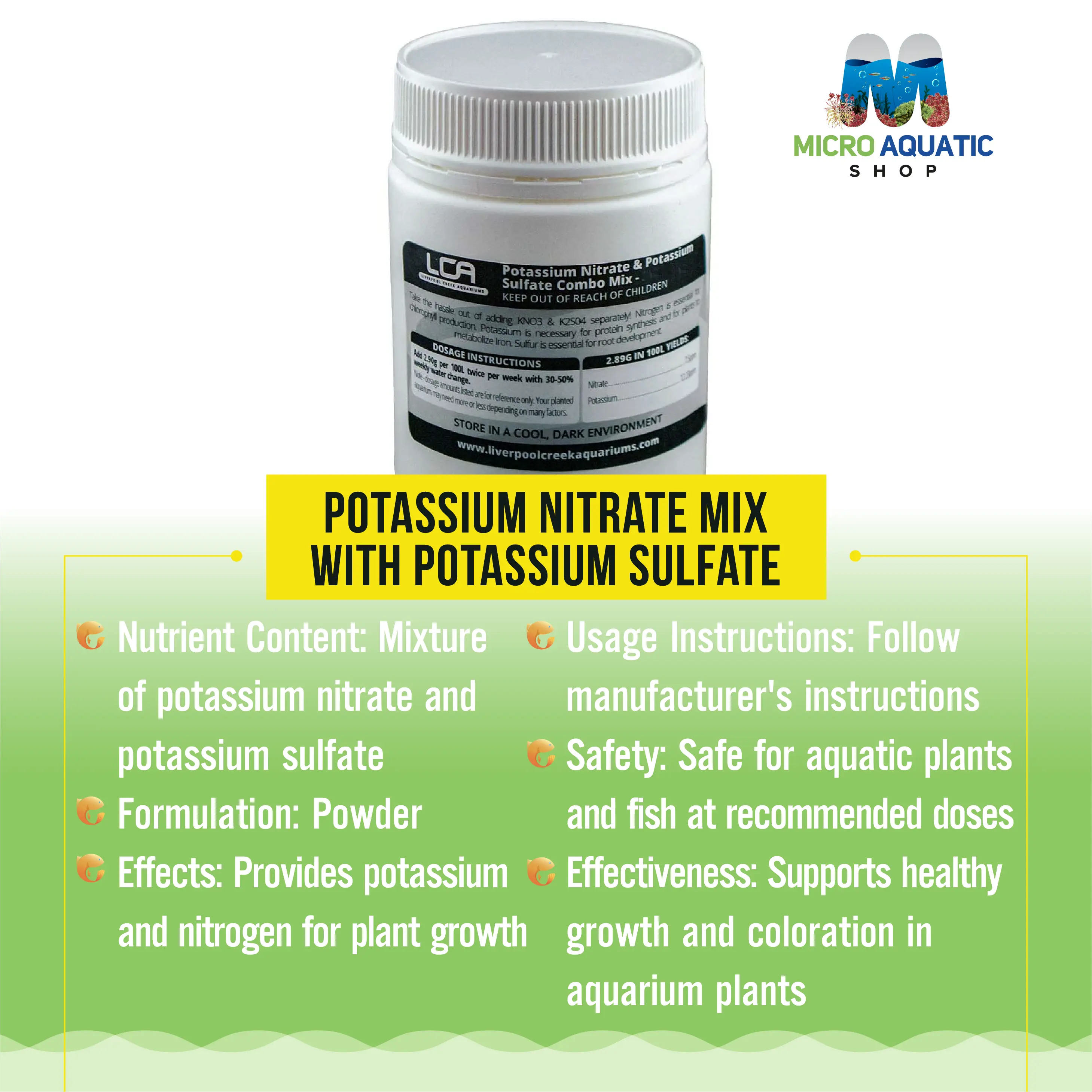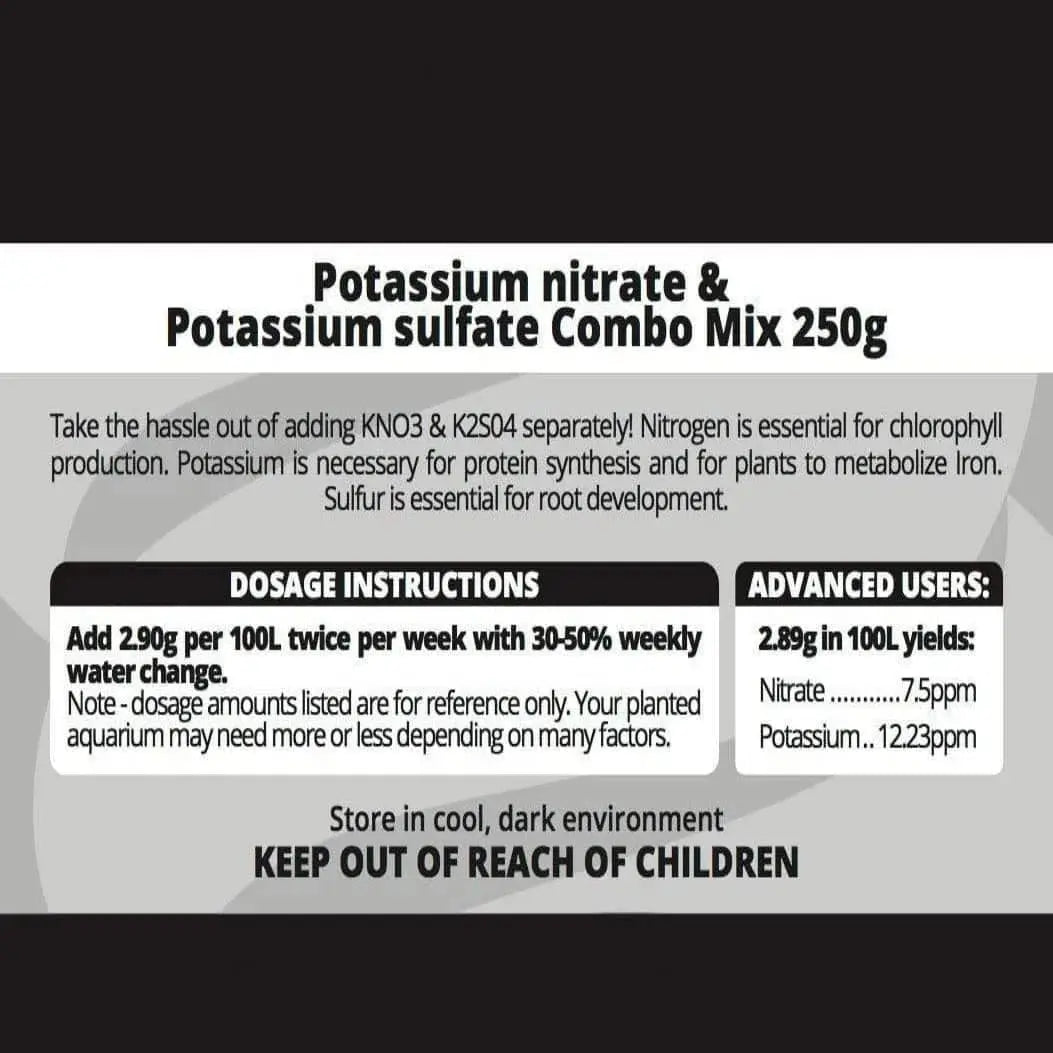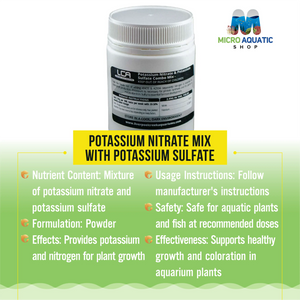Dosing Rate per 100L
Add 2.90 grams into 100 Litres tank twice per week with 30/50% weekly water change.
*Amounts above are for reference only. Your planted aquarium may need more or less depending on many factors.
For advanced users:
Store in cool dark environment
KEEP OUT OF REACH OF CHILDREN
Add 2.90 grams into 100 Litres tank twice per week with 30/50% weekly water change.
*Amounts above are for reference only. Your planted aquarium may need more or less depending on many factors.
For advanced users:
- Dosing: 2.89 Grams into 100 Litres will add
- 7.5ppm N03
- 12.23ppm K
Store in cool dark environment
KEEP OUT OF REACH OF CHILDREN
Besides light and carbon dioxide, Nitrogen is the most needed element by aquatic plants to grow healthy. After carbon, this is the element plants need the most amounts. A nitrogen deficiency results in slower growth of aquatic plants, which is also the reason for algae growth.
Why plants need nitrogen?
Plants require nitrogen for hundreds of things. As an example, all amino acids have nitrogen in them. Amino acids are the building blocks of proteins, without which no life can sustain. Nitrogen is also an important part of chlorophyll, nucleic acid and plant hormones.
The air we breathe has 78% Nitrogen in the gaseous form, but plants are unable to use it in the gaseous form. The most usable state of nitrogen for aquatic plants is ammonium (NH4) and Nitrate (NO3). Some plants can also absorb nitrogen that is in the form of urea (CH4N20). The nitrogen cycle is very important for both terrestrial and aquatic plants. This cycle explains the conversion of ammonia, nitrate, nitrite, ammonium, urea to gaseous nitrogen, which is performed by a bacterial colony.
Sources of Nitrogen in an aquarium:
In the aquarium, leftover fish food, various organic compounds, fish waste, etc. degrades and produces ammonium. A good bacterial colony will convert it to nitrate by this process: Ammonium àNitrite à Nitrate. This organic source of nitrogen can often be insufficient for a heavily planted tank.
How plants use nitrogen?
Some species of aquatic plants prefer nitrogen in the ammonium form, while some other species prefer it in nitrate form. Some plants even use both of these forms. It takes a lot of energy to convert nitrate into ammonium, however, vacuoles in the cell of the plants can store nitrate ions and they have high transportation speed within the plants. Unlike nitrate, ammonium is never stored within the plants. They are used right away or converted to nitrate by a bacterial colony. If the pH of the water becomes more than 7.5, ammonium can turn into ammonia, which is poisonous and also the reason for high algae growth. High level of nitrate forms inorganic sources such as Potassium Nitrate
(KNO3), which is not poisonous for many organisms in the planted tank.
Nitrogen Deficiency Symptoms:
=>Plants turn to yellowish color. The older leaves become more yellowish than the younger ones, though the older leaves do not die.
=>Smaller leaves becoming lighter in color is also an indicator for nitrogen deficiency.
=>Nitrogen deficiency also results in a very slow growth rate of aquatic plants.
=> Some species of plants may show a reddish discoloration.
Dosage rate for 100L Tank
Low Light Tank 1.5 gram once per week - 50% weekly water change approx
Medium Light Tank 3.0 gram twice per week - 50% weekly water change
High Light Tank 4.5 gram three times per week - 50% weekly water change
Why plants need nitrogen?
Plants require nitrogen for hundreds of things. As an example, all amino acids have nitrogen in them. Amino acids are the building blocks of proteins, without which no life can sustain. Nitrogen is also an important part of chlorophyll, nucleic acid and plant hormones.
The air we breathe has 78% Nitrogen in the gaseous form, but plants are unable to use it in the gaseous form. The most usable state of nitrogen for aquatic plants is ammonium (NH4) and Nitrate (NO3). Some plants can also absorb nitrogen that is in the form of urea (CH4N20). The nitrogen cycle is very important for both terrestrial and aquatic plants. This cycle explains the conversion of ammonia, nitrate, nitrite, ammonium, urea to gaseous nitrogen, which is performed by a bacterial colony.
Sources of Nitrogen in an aquarium:
In the aquarium, leftover fish food, various organic compounds, fish waste, etc. degrades and produces ammonium. A good bacterial colony will convert it to nitrate by this process: Ammonium àNitrite à Nitrate. This organic source of nitrogen can often be insufficient for a heavily planted tank.
How plants use nitrogen?
Some species of aquatic plants prefer nitrogen in the ammonium form, while some other species prefer it in nitrate form. Some plants even use both of these forms. It takes a lot of energy to convert nitrate into ammonium, however, vacuoles in the cell of the plants can store nitrate ions and they have high transportation speed within the plants. Unlike nitrate, ammonium is never stored within the plants. They are used right away or converted to nitrate by a bacterial colony. If the pH of the water becomes more than 7.5, ammonium can turn into ammonia, which is poisonous and also the reason for high algae growth. High level of nitrate forms inorganic sources such as Potassium Nitrate
(KNO3), which is not poisonous for many organisms in the planted tank.
Nitrogen Deficiency Symptoms:
=>Plants turn to yellowish color. The older leaves become more yellowish than the younger ones, though the older leaves do not die.
=>Smaller leaves becoming lighter in color is also an indicator for nitrogen deficiency.
=>Nitrogen deficiency also results in a very slow growth rate of aquatic plants.
=> Some species of plants may show a reddish discoloration.
Dosage rate for 100L Tank
Low Light Tank 1.5 gram once per week - 50% weekly water change approx
Medium Light Tank 3.0 gram twice per week - 50% weekly water change
High Light Tank 4.5 gram three times per week - 50% weekly water change
Limited Quantity Available - Will Sell out Fast!
There is absolutely ZERO Risk in buying from our trusted store as we use Encrypted SSL certificates for 100% Security so you don't have to worry about your security!





